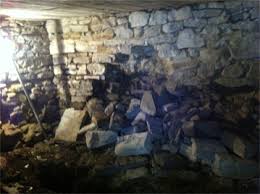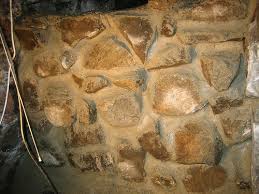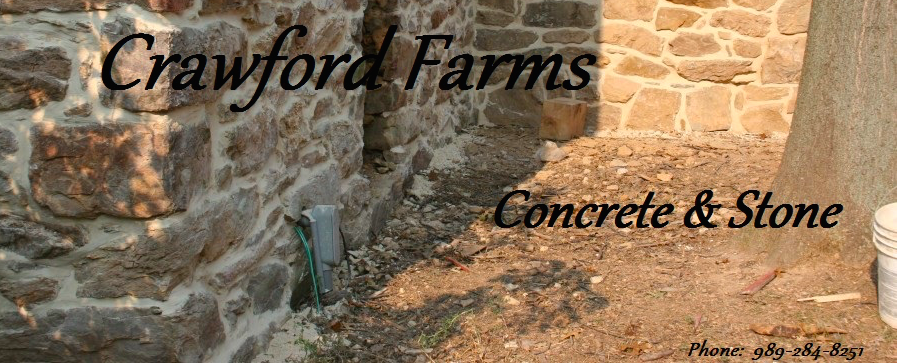 Many of the field stone foundations we work on throughout Michigan have the same common problem which is crumbling mortar joints between the stones. Often times there are other issues that are project specific, but the degradation of the mortar joints is pretty common regardless of the other items homeowner want us repair. There are several factors that determine how we go about repairing a particular stone foundation. Field stone basements under old farm houses need to be treated differently than a crawl space or an Old barn foundations. Unwanted water is often times an issue too, whether its just dampness or standing water in basement. Repairing bad mortar joints isn’t a big deal if it is done before the walls start to move and stones start to fall. It’s much less expensive than a complete rebuild of a section of wall. You can get more information on our stone foundation repair page, and get a quote.
Many of the field stone foundations we work on throughout Michigan have the same common problem which is crumbling mortar joints between the stones. Often times there are other issues that are project specific, but the degradation of the mortar joints is pretty common regardless of the other items homeowner want us repair. There are several factors that determine how we go about repairing a particular stone foundation. Field stone basements under old farm houses need to be treated differently than a crawl space or an Old barn foundations. Unwanted water is often times an issue too, whether its just dampness or standing water in basement. Repairing bad mortar joints isn’t a big deal if it is done before the walls start to move and stones start to fall. It’s much less expensive than a complete rebuild of a section of wall. You can get more information on our stone foundation repair page, and get a quote.
Most of the Michigan basements we repair fall into 3 categories of use, this makes a difference how we go about repairing crumbling mortar and repairing walls as well. Some people actually have living areas in their stone basements, though this is rare, some of these living areas are quite nice. The second category, and most common, is a basement that is used to house the water heater, furnace and other utilities. There might be a light down there, but for the most part its an oversized utility room. Then I’d say the third category is a basement that is simply a foundation and that’s it. They have nothing in them, they are basically just a place for duct work and are more like a tall crawl space.
How We Fix Crumbling Mortar In Stone Basements
The first thing I look at is how the basement is used by the homeowner, this makes a big difference in how the repairs are approached. For instance if a person uses their basement for a living area, they usually are concerned with the appearance of the finished product. It takes a considerable amount more work and time to create a nice looking finished stone wall when doing repairs. These basements tend to cost more when we go in a repair the crumbling mortar joints. Usually we are working with a basement that is used to house utilities and maybe light storage. Most folks with these type of basement aren’t too concerned with the aesthetic look of the finished wall, they are more concerned with function and structural integrity. The stone foundations that are just foundations and never accessed are again a group of clients who are concerned with structural integrity and that’s about it.
The process of fixing crumbling mortar in a stone wall is quite tedious, but it’s also pretty simple. We take out the crumbling rotting mortar and put new in. The type of mortar used to repair the crumbling joints is the most important factor. We determine this by what type of stone the wall is made of and the condition the stone is in. We are usually able to get a pretty clean joint environment but we usually use a bonding agent just to be safe. Once I know the type of mortar I will use to repair the rotten mortar joints I start removing the old mortar.
How to Remove Crumbling Mortar Joints
I usually find that most foundations have areas that are completely rotten, some that have been repaired, and others that have held up well over the years. Ultimately I have to work with what is there. Using a brick hammer I investigate the joints by a constant tapping on the joints, when I hear a hollow I work the mortar out of the area until I come to a place that is solid, then I continue on to the next area that needs removed. The work is tedious, but quite simple really. I’ve worked on old barn foundation where I used a high pressure garden hose and simply blasted the mortar and dirt right out of the wall. It’s important to be careful when removing the mortar so the stones themselves aren’t disturbed. Most walls we work on are still standing and straight, we just need to keep them that way by removing the motor debris and replacing it with a new mortar joint. I prefer to remove the old mortar with the brick hammer because I can hear, see and feel what is going on. I’ve used pneumatic hammers before and just don’t like the way the work for most projects. It’s noisy, dusty, and you really don’t know how much force you are using and I don’t feel it’s good for the stone.
I typically remove and from the top down and work an area of 6′ or so. I like to remove the bad joints, clean the wall and “re-tuck” new mortar joints in that area then move to a different area and do the same. This maintains the structural integrity of the wall and saves on supporting the beams and such you may be working around. It’s crucial to make sure the new mortar goes in and behind the stone so it bonds and binds.
How to Preserve A Crumbling Stone Foundation
One thing I see people do in old stone basements is try to shore up or support beams and floor joists. Most people think that by taking the weight off the stone wall they will keep  everything from moving and stop the wall from crumbling. The opposite is actually true. A stone, or even block wall gets it’s lateral strength from the weight or pressure applied down onto the wall. In other words, if you take the weight off the wall it is much more likely to move, buckle, or fall in.
everything from moving and stop the wall from crumbling. The opposite is actually true. A stone, or even block wall gets it’s lateral strength from the weight or pressure applied down onto the wall. In other words, if you take the weight off the wall it is much more likely to move, buckle, or fall in.
Best way to preserver your stone foundation is to repair the crumbling mortar. In the meantime you are better off leaving it alone. The degradation of a stone wall is a slow process and leaving it be is usually the best bet, until you can get it repaired that is. One thing that can help is to make sure the ground water around the foundation is running away from the house at ground level. Water moves dirt and it moves mortar, you don’t want water running into and through your stone foundation wall.
When Is the Best Time to Repair A Stone Basement?
There are many factors that play into when you decide to get your foundation fixed. Things like budget, work schedule, and summer travel and other plans impact the decision when to start a foundation repair project. In terms of cost, I’d tell anyone to consider getting a stone foundation repaired during the winter. By far the largest portion of foundation work will happen inside the basement. There is more area to cover on the interior walls and usually only a couple feet sticking out of the ground on the exterior. More than anything it is a supply and demand thing. I have a lot more time in the winter and cash flow slows down to a trickle for me in the winter months. Most people call and want their projects done in the spring and the spring thaw seems to start it all off. It doesn’t really matter when you start your project in terms of weather, you’ll save money by doing it in the winter months. I’ve went back when it warms up to do the exterior portion of several projects. This also gives me a chance to look at work previously done to see if I missed anything or need to do anything else.
Would You Like a Quote To Repair Crumbling Mortar in Your Foundation?
If you would like to get a quote to have your foundation problem fixed or just have some questions I’d be happy to help. You can send me a about your stone foundation repair and I’ll be in touch. Give me a little information about your foundation, some things to include are:
- Is it a Basement or Crawlspace?
- Approximately how old is your stone foundation?
- When do you want the project started?
- Where is the job located?
- What budget are you working with?
You can get a stone foundation repair quote by visiting that link. I’ll get the note and send an email with a few questions and my phone number. If you’d like me to call just leave me your number in the quote request. I work all over the state of Michigan and look forward to learning more about your project.
Thanks,
J. Crawford

We bought a house in a small farm town in Saskatchewan. It was built in 1948. The entire basement has been framed and covered in plywood. We have water damage in most of the corners. Basement is about 548 square feet. We were told that we may have a stone and mortar foundation in this house. We were also told that our foundation may not hold the house once we remove the plywood to see what is going on? There is also an addition with I am sure a ground crawl on cement that is attached to the 1948 basement. It was built in 1982. We are going to retire and we are going to be on a fixed income which is not all that much. We do have some savings to fix this basement, but we have no idea how much something like this will cost. Help with a quote or suggestions if you can. We are in Togo, Saskatchewan.
Hello Diane,
I am in Northern Michigan and it would be really difficult to provide you with a quote for you basement without actually looking at it. Let’s say it needs re-tucked with new mortar and the stones are generally still in place, which I assume they are since you have a framed wood wall on the interior. If it were in the State of Michigan I would expect the price to re-tuck the walls to be in the area of $2,500 to $3,800.
Hope this helps.
I have a question about stone/mortar wall repair. I’ve looked at several websites that all talk about the maint. of the walls inside the basement. Is there a reason there doesn’t seem to be much concern for the condition of the mortar on the outside portion (that is under the ground)? I am looking a possible purchase of an older farm house and looking at ways to fix/repair/replace and costs before I make a decision. Also, is there a way to expand the basement? There is crawl space under an addition.
Thank you
Janice
Can you recommend anyone that does this work near Columbus Ohio? Assuming you only work in the state of Michigan
I live in Hillsdale Mi. I have a stone foundation. Do you want to give me a quote?
Yes, for sure, just go to the request a quote page or email me directly at joecrawfordonline@gmail.com